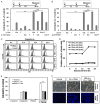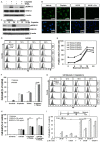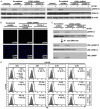Dual role of ERK2/NF-κB signaling in TRAIL sensitivity
- PMID: 35968322
- PMCID: PMC9360224
Dual role of ERK2/NF-κB signaling in TRAIL sensitivity
Abstract
Targeting tumor necrosis factor-related apoptosis-inducing ligand (TRAIL) signaling is a promising approach in cancer treatment. Although ERK and/or NF-κB signaling is involved in the expression of TRAIL receptors (TRAIL-R), the exact underlying mechanisms remain unknown. In this study, we evaluated the role of ERK2 and NF-κB in the cytotoxicity of TRAIL during cisplatin treatment. Cisplatin treatment of neuroepithelioma cells (SK-N-MC) significantly induced ERK2 activation and increased TRAIL cytotoxicity via the upregulation of death receptor 5 (DR5) expression. In partial ERK2 knockdown cell lines that maintained only basal levels of ERK2 activity, cisplatin treatment did not increase ERK2 activity or DR5 expression. These findings indicate that induced (rather than basal) ERK2 activity enhances TRAIL susceptibility via DR5 expression. In complete ERK2 knockdown cell lines with no basal ERK2 activity, DR4, DR5, and DcRs expression levels were increased, and additional treatment with cisplatin did not further increase TRAIL-R expression. Chemical inhibition of ERK2 also enhanced TRAIL cytotoxicity by upregulating DR4 and DR5 expression. These findings indicate that basal ERK2 activity suppresses TRAIL-R expression. Both basal and inducible ERK2 activities regulate TRAIL-R expression via the NF-κB signaling pathway. Overall, our findings suggest that the ERK2/NF-κB signaling pathway has a dual role in TRAIL susceptibility by differentially regulating TRAIL-R expression in the same cellular system.
Keywords: ERK2; NF-κB; TRAIL; cisplatin; death receptor.
AJCR Copyright © 2022.
Conflict of interest statement
None.
Figures









Similar articles
-
Implication of NF-κB and p53 in the expression of TRAIL-death receptors and apoptosis by apple procyanidins in human metastatic SW620 cells.Biomedica. 2010 Oct-Dec;30(4):577-86. Biomedica. 2010. PMID: 21713362
-
The enhanced expression of death receptor 5 (DR5) mediated by HBV X protein through NF-kappaB pathway is associated with cell apoptosis induced by (TNF-α related apoptosis inducing ligand) TRAIL in hepatoma cells.Virol J. 2015 Nov 17;12:192. doi: 10.1186/s12985-015-0416-z. Virol J. 2015. PMID: 26577955 Free PMC article.
-
Pro-survival effects by NF-κB, Akt and ERK(1/2) and anti-apoptosis actions by Six1 disrupt apoptotic functions of TRAIL-Dr4/5 pathway in ovarian cancer.Biomed Pharmacother. 2016 Dec;84:1078-1087. doi: 10.1016/j.biopha.2016.10.028. Epub 2016 Oct 22. Biomed Pharmacother. 2016. PMID: 27780136
-
TRAIL induces apoptosis but not necroptosis in colorectal and pancreatic cancer cells preferentially via the TRAIL-R2/DR5 receptor.Biochim Biophys Acta Mol Cell Res. 2018 Mar;1865(3):522-531. doi: 10.1016/j.bbamcr.2017.12.006. Epub 2017 Dec 24. Biochim Biophys Acta Mol Cell Res. 2018. PMID: 29278689
-
Suppression of HSP70 expression sensitizes NSCLC cell lines to TRAIL-induced apoptosis by upregulating DR4 and DR5 and downregulating c-FLIP-L expressions.J Mol Med (Berl). 2013 Feb;91(2):219-35. doi: 10.1007/s00109-012-0947-3. Epub 2012 Sep 5. J Mol Med (Berl). 2013. PMID: 22948392
Cited by
-
NF-κB in biology and targeted therapy: new insights and translational implications.Signal Transduct Target Ther. 2024 Mar 4;9(1):53. doi: 10.1038/s41392-024-01757-9. Signal Transduct Target Ther. 2024. PMID: 38433280 Free PMC article. Review.
References
-
- Wang S. The promise of cancer therapeutics targeting the TNF-related apoptosis-inducing ligand and TRAIL receptor pathway. Oncogene. 2008;27:6207–6215. - PubMed
-
- Wu GS, Burns TF, McDonald ER 3rd, Jiang W, Meng R, Krantz ID, Kao G, Gan DD, Zhou JY, Muschel R, Hamilton SR, Spinner NB, Markowitz S, Wu G, el-Deiry WS. KILLER/DR5 is a DNA damage-inducible p53-regulated death receptor gene. Nat Genet. 1997;17:141–143. - PubMed
-
- Pan G, O’Rourke K, Chinnaiyan AM, Gentz R, Ebner R, Ni J, Dixit VM. The receptor for the cytotoxic ligand TRAIL. Science. 1997;276:111–113. - PubMed
-
- Kischkel FC, Lawrence DA, Chuntharapai A, Schow P, Kim KJ, Ashkenazi A. Apo2L/TRAIL-dependent recruitment of endogenous FADD and caspase-8 to death receptors 4 and 5. Immunity. 2000;12:611–620. - PubMed
LinkOut - more resources
Full Text Sources
Miscellaneous
